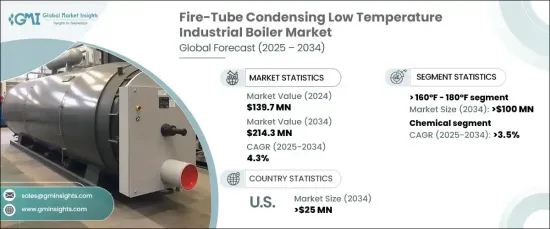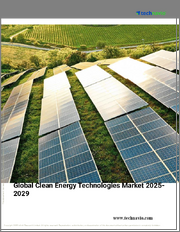
|
시장보고서
상품코드
1665411
화관식 응축 저온 산업용 보일러 시장 기회, 성장 촉진요인, 산업 동향 분석, 예측(2025-2034년)Fire-Tube Condensing Low Temperature Industrial Boiler Market Opportunity, Growth Drivers, Industry Trend Analysis, and Forecast 2025 - 2034 |
||||||
세계의 화관식 응축 저온 산업용 보일러 시장은 2024년에 1억 3,970만 달러로 평가되며, 2025-2034년에 CAGR 4.3%로 꾸준히 성장할 전망입니다. 이러한 성장의 주요 원동력은 기존 보일러 시스템의 지속적인 업그레이드와 함께 노후화된 산업 인프라의 현대화입니다. 보다 에너지 효율적이고 친환경적인 산업용 솔루션으로의 전환은 시장을 더욱 촉진할 가능성이 높습니다. 내구성과 내식성이 강화된 첨단 보일러 설계에 대한 투자 증가는 시장 전망을 강화할 것입니다. 또한 지속가능성과 친환경 에너지 솔루션에 대한 관심이 높아짐에 따라 산업용 보일러, 특히 최신 응축 기술과 첨단 제어 시스템을 활용한 보일러의 보급이 확대될 것으로 예상됩니다.

특히 식품 가공, 화학, 정유 등 정밀한 온도 제어가 필수적인 산업에 도입이 확대되면서 화관식 응축식 저온 산업용 보일러에 대한 수요가 급증할 것으로 예상됩니다. 예지보전을 위한 IoT 기반 모니터링 시스템의 적용을 포함한 기술 발전은 성능을 최적화하고 다운타임을 줄여줍니다. 이러한 기술 혁신은 시장 확대에 기여할 것으로 보입니다. 이러한 보일러의 에너지 효율이 높아짐에 따라 재생에너지 시스템을 사용하는 산업에서 보일러의 역할이 강화되고, 더 큰 성장 기회를 창출할 수 있을 것으로 예상됩니다.
| 시장 범위 | |
|---|---|
| 시작연도 | 2024년 |
| 예측연도 | 2025-2034년 |
| 시작 금액 | 1억 3,970만 달러 |
| 예상 금액 | 2억 1,430만 달러 |
| CAGR | 4.3% |
엄격한 환경 규제를 배경으로 한 화학 분야 등에서는 첨단 안전 기능, 모니터링 기능, 자동화 시스템 탑재가 진행되고 있습니다. 이러한 조치는 엄격한 안전 기준을 준수하는 동시에 신뢰할 수 있는 난방 시스템에 대한 수요 증가에 대응하기 위한 조치입니다. 이와 함께 의약품 및 특수 화학제품을 포함한 고품질 화학제품에 대한 수요 증가는 시장의 지속적인 성장을 지원할 것으로 보입니다.
미국의 경우, 이산화탄소 배출 감소와 운영 효율성 향상을 위한 공동의 노력에 힘입어 2034년까지 화관식 콘덴싱 저온 산업용 보일러 시장은 2,500만 달러 이상 시장으로 성장할 것으로 예상됩니다. 기술 혁신과 품질 향상에 대한 지속적인 투자와 진화하는 에너지 효율 표준을 준수하는 것이 시장 성장의 주요 요인입니다. 이러한 확대는 산업 시설의 업그레이드에 대한 대규모 투자에 힘입어 예측 기간 중 산업 성장을 더욱 촉진할 것으로 예상됩니다.
목차
제1장 조사 방법과 조사 범위
- 시장 범위와 정의
- 시장 추산·예측 파라미터
- 예측 계산
- 데이터 소스
- 1차 데이터
- 2차 데이터
- 유료
- 공적
제2장 개요
제3장 업계 인사이트
- 에코시스템 분석
- 규제 상황
- 업계에 대한 영향요인
- 촉진요인
- 업계의 잠재적 리스크 & 과제
- 성장 가능성 분석
- Porter의 산업 분석
- 공급 기업의 교섭력
- 바이어의 교섭력
- 신규 진출업체의 위협
- 대체품의 위협
- PESTEL 분석
제4장 경쟁 구도
- 서론
- 전략적 전망
- 혁신과 지속가능성 전망
제5장 시장 규모·예측 : 온도별, 2021-2034년
- 주요 동향
- 120℉ 이하
- 120℉ 초과-140℉
- 140℉ 초과-160℉
- 160℉ 초과-180℉
제6장 시장 규모·예측 : 용량별, 2021-2034년
- 주요 동향
- 10 MMBTU/hr 미만
- 10-25 MMBTU/hr
- 25-50 MMBTU/hr
- 50-75 MMBTU/hr
- 75-100 MMBTU/hr
- 100-175 MMBTU/hr
- 175-250 MMBTU/hr
- 250 MMBTU/hr 초과
제7장 시장 규모·예측 : 연료별, 2021-2034년
- 주요 동향
- 천연가스
- 석유
- 석탄
- 기타
제8장 시장 규모·예측 : 용도별, 2021-2034년
- 주요 동향
- 식품 가공
- 펄프 및 제지
- 화학
- 정제
- 일차 금속
- 기타
제9장 시장 규모·예측 : 지역별, 2021-2034년
- 주요 동향
- 북미
- 미국
- 캐나다
- 멕시코
- 유럽
- 프랑스
- 영국
- 폴란드
- 이탈리아
- 스페인
- 오스트리아
- 독일
- 스웨덴
- 러시아
- 아시아태평양
- 중국
- 인도
- 필리핀
- 일본
- 한국
- 호주
- 인도네시아
- 중동 및 아프리카
- 사우디아라비아
- 이란
- 아랍에미리트
- 나이지리아
- 남아프리카공화국
- 라틴아메리카
- 아르헨티나
- 칠레
- 브라질
제10장 기업 개요
- Babcock Wanson
- Burnham Commercial Boilers
- Clayton Industries
- Cleaver Brooks
- EPCB Boiler
- Ferroli
- Fulton
- Hoval
- Hurst Boiler &Welding
- IHI Corporation
- Miura America
- Superior Boilers
- Thermax
- Thermodyne Boilers
- Victory Energy Operations
The Global Fire-Tube Condensing Low Temperature Industrial Boiler Market, valued at USD 139.7 million in 2024, is poised for steady growth at a CAGR of 4.3% from 2025 to 2034. This growth is primarily driven by the modernization of aging industrial infrastructure, in line with the ongoing upgrade of existing boiler systems. The shift toward more energy-efficient and environmentally friendly industrial solutions is likely to propel the market further. Rising investments in advanced boiler designs featuring enhanced durability and corrosion resistance are set to boost the market's prospects. Furthermore, the increasing emphasis on sustainability and eco-conscious energy solutions is expected to promote broader adoption of industrial boilers, particularly those leveraging the latest advancements in condensing technology and sophisticated control systems.

The demand for fire-tube condensing low-temperature industrial boilers is set to soar, especially with their integration into industries such as food processing, chemicals, and refineries, where precision in temperature control is essential. Technological advancements, including the application of IoT-based monitoring systems for predictive maintenance, will optimize performance and reduce downtime. These innovations will contribute to market expansion. As these boilers become more energy-efficient, their role in industries utilizing renewable energy systems will strengthen, creating significant opportunities for further growth.
| Market Scope | |
|---|---|
| Start Year | 2024 |
| Forecast Year | 2025-2034 |
| Start Value | $139.7 Million |
| Forecast Value | $214.3 Million |
| CAGR | 4.3% |
In sectors like chemicals driven by stringent environmental regulations, fire-tube condensing boilers are increasingly equipped with advanced safety features, monitoring capabilities, and automated systems. These measures ensure compliance with tough safety standards while addressing the rising demand for reliable heating systems. Alongside this, the growing need for high-quality chemical products, including pharmaceuticals and specialty chemicals, will support the continued growth of the market.
In the U.S., the fire-tube condensing low-temperature industrial boiler market is on track to exceed USD 25 million by 2034, driven by a concerted focus on carbon emission reduction and boosting operational efficiency. Continuous investments in technological innovation and quality improvement, along with compliance with evolving energy efficiency standards, are key factors in market growth. This expansion is also bolstered by significant investments in industrial facility upgrades, which will further propel industry growth over the forecast timeframe.
Table of Contents
Chapter 1 Methodology & Scope
- 1.1 Market scope & definitions
- 1.2 Market estimates & forecast parameters
- 1.3 Forecast calculation
- 1.4 Data sources
- 1.4.1 Primary
- 1.4.2 Secondary
- 1.4.2.1 Paid
- 1.4.2.2 Public
Chapter 2 Executive Summary
- 2.1 Industry synopsis, 2021 - 2034
Chapter 3 Industry Insights
- 3.1 Industry ecosystem analysis
- 3.2 Regulatory landscape
- 3.3 Industry impact forces
- 3.3.1 Growth drivers
- 3.3.2 Industry pitfalls & challenges
- 3.4 Growth potential analysis
- 3.5 Porter's Analysis
- 3.5.1 Bargaining power of suppliers
- 3.5.2 Bargaining power of buyers
- 3.5.3 Threat of new entrants
- 3.5.4 Threat of substitutes
- 3.6 PESTEL Analysis
Chapter 4 Competitive Landscape, 2024
- 4.1 Introduction
- 4.2 Strategic outlook
- 4.3 Innovation & sustainability landscape
Chapter 5 Market Size and Forecast, By Temperature, 2021 – 2034 (Units, MMBTU/hr & USD Million)
- 5.1 Key trends
- 5.2 ≤ 120°F
- 5.3 > 120°F - 140°F
- 5.4 > 140°F - 160°F
- 5.5 > 160°F - 180°F
Chapter 6 Market Size and Forecast, By Capacity, 2021 – 2034 (Units, MMBTU/hr & USD Million)
- 6.1 Key trends
- 6.2 < 10 MMBTU/hr
- 6.3 10 - 25 MMBTU/hr
- 6.4 25 - 50 MMBTU/hr
- 6.5 50 - 75 MMBTU/hr
- 6.6 75 - 100 MMBTU/hr
- 6.7 100 - 175 MMBTU/hr
- 6.8 175 - 250 MMBTU/hr
- 6.9 > 250 MMBTU/hr
Chapter 7 Market Size and Forecast, By Fuel, 2021 – 2034 (Units, MMBTU/hr & USD Million)
- 7.1 Key trends
- 7.2 Natural gas
- 7.3 Oil
- 7.4 Coal
- 7.5 Others
Chapter 8 Market Size and Forecast, By Application, 2021 – 2034 (Units, MMBTU/hr & USD Million)
- 8.1 Key trends
- 8.2 Food processing
- 8.3 Pulp & paper
- 8.4 Chemical
- 8.5 Refinery
- 8.6 Primary metal
- 8.7 Others
Chapter 9 Market Size and Forecast, By Region, 2021 – 2034 (Units & USD Million)
- 9.1 Key trends
- 9.2 North America
- 9.2.1 U.S.
- 9.2.2 Canada
- 9.2.3 Mexico
- 9.3 Europe
- 9.3.1 France
- 9.3.2 UK
- 9.3.3 Poland
- 9.3.4 Italy
- 9.3.5 Spain
- 9.3.6 Austria
- 9.3.7 Germany
- 9.3.8 Sweden
- 9.3.9 Russia
- 9.4 Asia Pacific
- 9.4.1 China
- 9.4.2 India
- 9.4.3 Philippines
- 9.4.4 Japan
- 9.4.5 South Korea
- 9.4.6 Australia
- 9.4.7 Indonesia
- 9.5 Middle East & Africa
- 9.5.1 Saudi Arabia
- 9.5.2 Iran
- 9.5.3 UAE
- 9.5.4 Nigeria
- 9.5.5 South Africa
- 9.6 Latin America
- 9.6.1 Argentina
- 9.6.2 Chile
- 9.6.3 Brazil
Chapter 10 Company Profiles
- 10.1 Babcock Wanson
- 10.2 Burnham Commercial Boilers
- 10.3 Clayton Industries
- 10.4 Cleaver Brooks
- 10.5 EPCB Boiler
- 10.6 Ferroli
- 10.7 Fulton
- 10.8 Hoval
- 10.9 Hurst Boiler & Welding
- 10.10 IHI Corporation
- 10.11 Miura America
- 10.12 Superior Boilers
- 10.13 Thermax
- 10.14 Thermodyne Boilers
- 10.15 Victory Energy Operations



















